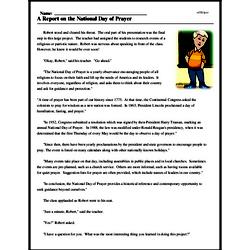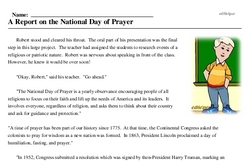A Report on the National Day of Prayer
National Day of Prayer
Reading Comprehension for May 2
Robert stood and cleared his throat. The oral part of his presentation was the final step in this large project. The teacher had assigned the students to research events of a religious or patriotic nature. Robert was nervous about speaking in front of the class. However, he knew it would be over soon!
"Okay, Robert," said his teacher. "Go ahead."
"The National Day of Prayer is a yearly observance encouraging people of all religions to focus on their faith and lift up the needs of America and its leaders. It involves everyone, regardless of religion, and asks them to think about their country and ask for guidance and protection."
"A time of prayer has been part of our history since 1775. At that time, the Continental Congress asked the colonists to pray for wisdom as a new nation was formed. In 1863, President Lincoln proclaimed a day of humiliation, fasting, and prayer."
"In 1952, Congress submitted a resolution which was signed by then-President Harry Truman, marking an annual National Day of Prayer. In 1988, the law was modified under Ronald Reagan's presidency, when it was determined that the first Thursday of every May would be the day to observe a day of prayer."
"Since then, there have been yearly proclamations by the president and state governors to encourage people to pray. The event is listed on many calendars along with other nationally-known holidays."
"Many events take place on that day, including assemblies in public places and in local churches. Sometimes the events are pre-planned, such as a church service. Others are more informal, such as having rooms available for quiet prayer. Suggestion lists for prayer are often provided, which include names of leaders in our country."
"In conclusion, the National Day of Prayer provides a historical reference and contemporary opportunity to seek guidance beyond ourselves."
The class applauded as Robert went to his seat.




